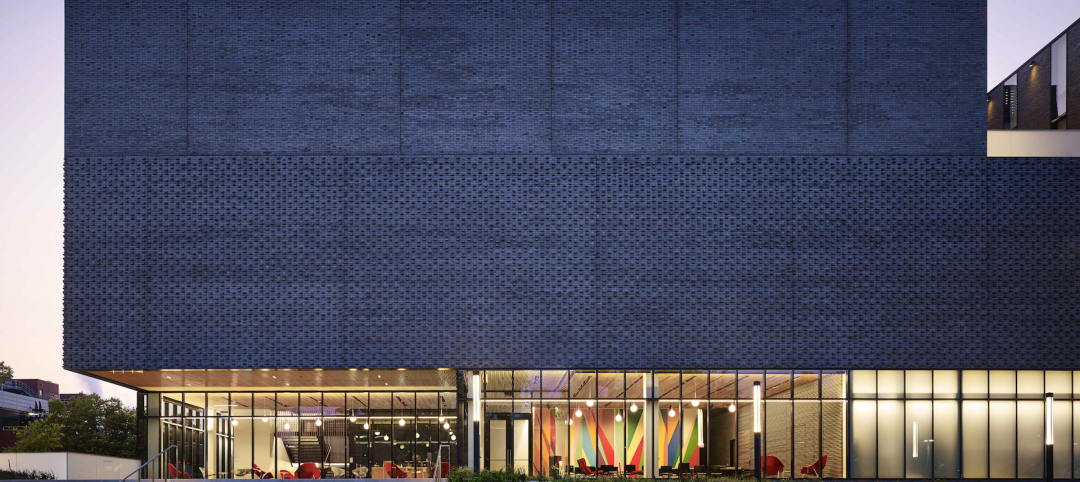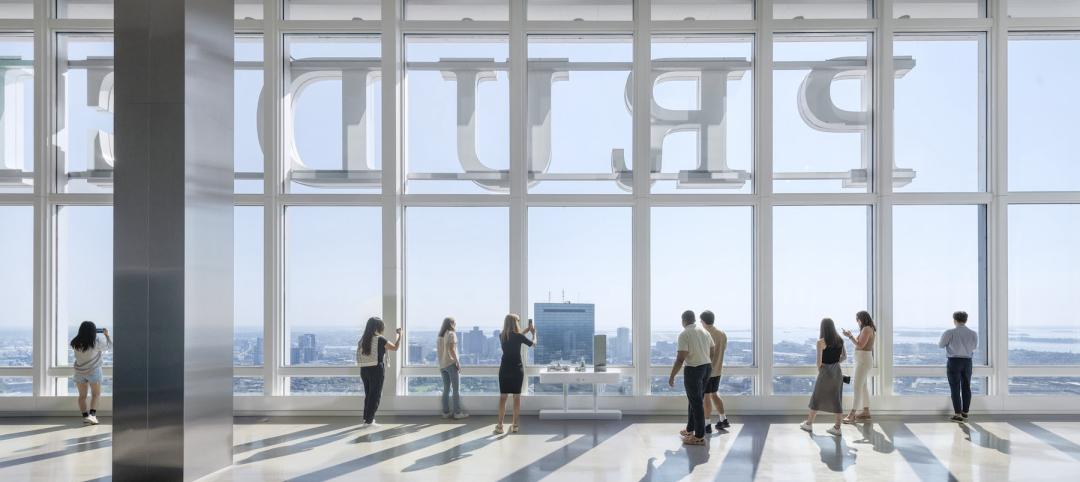How important are athletic programs to U.S. school districts? Here's one leading indicator: In 2005, the National Football League sold 17 million tickets. That same year, America's high schools sold an estimated 225 million tickets to football games, according to the American Football Coaches Association.
In towns and cities across the nation, student athletics are both a thriving industry and a source of community pride. To keep up with demand, public school districts are replacing antiquated facilities with increasingly sophisticated sports complexes that rival, at a somewhat smaller scale, anything to be found in professional venues.
Nowhere is this phenomenon more pronounced than in Texas, where high school athletics has been dramatized in the film and TV series “Friday Night Lights.” Lured by the advertising, gate revenue, and publicity that can be accrued from hosting playoff games and tournaments, school districts and communities in the Lone Star state are creating ever more sophisticated stadiums and athletic facilities.
In Texas, stadiums and athletic centers may serve students from several school districts. They may involve complex partnerships between school districts and city or county governments, or even shared arrangements with professional sports teams. The newest facilities feature such amenities as suites, state-of-the-art press boxes, and the latest artificial turf to guard against injuries to student athletes.
 Pizza Hut Park in Frisco, Texas, is the home of the FC Dallas Major League Soccer Team. It's also the home of the home stadium for Frisco Independent School District high school football. The complex also includes 17 championship-quality soccer fields and hosts tournaments and concerts. All photos by HKS/Blake Marvin |
“The obvious reason for updating is growth,” said Mark VanderVoort, AIA, SVP of education facilities for Dallas-based architects HKS, Inc., which has worked on five high school stadium projects in the last four years. Older facilities, some dating to the late '40s and '50s, may not have enough seats or enough fields to meet scheduling demands in growing communities, he notes. In some cases, a school district may choose to build a larger facility at a specific high school, or it may build a centralized facility on a separate site for several schools, making it a new focal point for the community.
Partnering with the pros
One of the prime examples of this phenomenon is Pizza Hut Park, home of Major League Soccer's FC Dallas soccer club, and also home to the four different high school football teams in the Frisco Independent School District just north of Dallas. The 21,193-seat stadium, with its 18,500-sf skybox suites and luxury restaurant, is part of a 117-acre complex that takes in 17 championship-quality soccer fields (also shared with the school district), as well as a 300-seat junior varsity football facility with press box and scoreboard.
Completed in late 2005, the HKS-designed complex was created through a four-way deal between Hunt Sports Group (owner of FC Dallas), the city of Frisco and its economic and community development corporations, the Frisco Independent School District, and Collin County.
“The county was looking to build recreational fields for soccer in that area and the school district had already funded and started design work on a new high school football field,” said Craig Stockwell, AIA, principal in charge of the project for HKS. “The city wanted to bring the MLS team there—they were playing at the Cotton Bowl at the time—to create a soccer complex that would also double as a high school football stadium.”
The school district had budgeted $23 million for design and construction of a stadium, but by entering into the public-private partnership, the district was able to get a bigger, better facility for a contribution of only $10 million. The total cost of the complex was $80 million, with Hunt Sports Group contributing $25 million and the city and county picking up the rest of the tab.
The city of Frisco owns the stadium and soccer complex, while HSG manages the facility and books concert dates at it through a deal with Anschutz Entertainment Group. Ancillary revenue from parking, the $25 million Pizza Hut naming rights deal, and concert revenue is shared between HSG and the city/county partnership.
The city and county agreed to let the sports people from HSG make all major design and construction decisions. “Hunt was recognized as the project leader from the outset,” said Stockwell. By creating what Stockwell calls “the ultimate multipurpose facility,” HSG was able book tournaments, playoff games, and numerous other events. “The complex was used 300 days in 2006,” he says. The school district gets the use of the stadium on scheduled Fridays during football season and shares in high school playoff and tournament revenue.
Stockwell said the stadium was intentionally designed with an unobstructed concourse for the nonstop action of soccer, but that design philosophy was also utilized to allow it to be adaptable enough to host concerts for up to 30,000 music fans, high school football games that usually seat around 10,000, U.S. National Soccer Team matches, and the 2005 MLS Cup.
It was also the final stadium project for NFL and National Soccer Hall of Fame member Lamar Hunt, who died last December of complications related to prostate cancer. “He was very involved in the project,” says Stockwell. “He sent us sketches and came to every design presentation and all job site meetings during construction.”
One for all: maximizing revenue, consolidating functions
Pizza Hut Park is used by four different schools in Frisco and shares facilities for both high school football and soccer. Building one facility for several schools in a district is a way to maximize a new facility's revenue potential and create a more sophisticated gathering place that can host playoffs and other events.
The $33 million Dallas Independent School District complex serves 12 high schools in south Dallas and encompasses a 12,000-seat stadium, a 7,500-seat fieldhouse, and shared parking. While it has a high-tech scoreboard, press box, and the newest FieldTurf, it also consolidates support functions such as locker rooms and training facilities. This allows it to be situated on roughly half the site area typically needed for a stadium and fieldhouse of its size, saving the district considerable construction costs.
 Midlothian Stadium has offset grandstands near the corners of its field to give a visible performance position to each school's marching band. |
“Another driver of these facilities is simply keeping up with the Joneses,” said HKS's VanderVoort. “The Dallas facility was designed to match service capability for a similar complex on the north side of Dallas. But even at its cost of $33 million, there is significant savings for the district here, because it is serving both basketball and football. It's also serving 12 schools, so there's less construction cost for the parking, and the people in south Dallas can now host their own playoff games. It's an expression of how the students and parents feel about themselves and the community of south Dallas.”
The Midlothian Independent School District, another growing community 30 miles south of Dallas, capitalized on a natural setting by building its new $14.2 million football and soccer stadium, completed in late 2006, in a ravine.
What allowed the 8,176-seat bowl to be carved out of a natural ravine were pre-cast concrete mass-stabilized-earth (MSE) retaining walls. The MSE walls, used mostly in highway construction, hold back the ravine walls to form the bowl 12-15 feet above grade. Cheaper than buildi
 In addition to a 12,000-seat stadium, the Dallas Independent School District's complex also includes a 7,500-seat fieldhouse. |
ng full grandstands, the retaining walls were a cost-effective and sound way to form a natural seating bowl. This results in a design that is “more of a park setting,” says HKS's VanderVoort.
Another nice touch was suggested by the client: locating the seating areas for the bands and drill teams in the corners of the stadium facing the field at a 45-degree angle. “It eliminates the havoc of sitting on the same side as your band and not being able to hear them,” says VanderVoort.”
As at Pizza Hut Park, the Midlothian stadium also uses an open concourse design with four concession stands, plus restrooms situated on the corners of the field. This is a feature HKS is using on nearly all of its stadium projects.
Amenities include 2,000 parking spaces and a two-story press box. The Midlothian school district brought in nearly $90,000 in advertising revenue from the stadium in its first season, in addition to revenue from hosting band competitions and other events.
Related Stories
Sponsored | Performing Arts Centers | Jan 17, 2024
Performance-based facilities for performing arts boost the bottom line
A look at design trends for “budget-wise” performing arts facilities reveals ways in which well-planned and well-built facilities help performers and audiences get the most out of the arts. This continuing education course is worth 1.0 AIA learning unit.
Cultural Facilities | Nov 21, 2023
Arizona’s Water Education Center will teach visitors about water conservation and reuse strategies
Phoenix-based architecture firm Jones Studio will design the Water Education Center for Central Arizona Project (CAP)—a 336-mile aqueduct system that delivers Colorado River water to almost 6 million people, more than 80% of the state’s population. The Center will allow the public to explore CAP’s history, operations, and impact on Arizona.
Giants 400 | Nov 6, 2023
Top 65 Cultural Facility Construction Firms for 2023
Turner Construction, Clark Group, Whiting-Turner, Gilbane, and Holder Construction top BD+C's ranking of the nation's largest cultural facilities sector general contractors and construction management (CM) firms for 2023, as reported in the 2023 Giants 400 Report. Note: This ranking includes revenue from all cultural building sectors, including concert venues, art galleries, museums, performing arts centers, and public libraries.
Giants 400 | Nov 6, 2023
Top 60 Cultural Facility Engineering Firms for 2023
KPFF, Arup, Thornton Tomasetti, Tetra Tech, and WSP head BD+C's ranking of the nation's largest cultural facilities sector engineering and engineering architecture (EA) firms for 2023, as reported in the 2023 Giants 400 Report. Note: This ranking includes revenue from all cultural building sectors, including concert venues, art galleries, museums, performing arts centers, and public libraries.
Giants 400 | Nov 6, 2023
Top 110 Cultural Facility Architecture Firms for 2023
Populous, Gensler, HGA, DLR Group, and Quinn Evans top BD+C's ranking of the nation's largest cultural facilities sector architecture and architecture engineering (AE) firms for 2023, as reported in the 2023 Giants 400 Report. Note: This ranking includes revenue from all cultural building sectors, including concert venues, art galleries, museums, performing arts centers, and public libraries.
Cultural Facilities | Sep 24, 2023
Boston’s Prudential Center showcases a new three-floor observatory
A reconfiguration of mechanical and cooling systems made way for “View Boston,” designed by Perkins & Will.
Mass Timber | Sep 1, 2023
Community-driven library project brings CLT to La Conner, Wash.
The project, designed by Seattle-based architecture firm BuildingWork, was conceived with the history and culture of the local Swinomish Indian Tribal Community in mind.
Laboratories | Aug 24, 2023
Net-zero carbon science center breaks ground in Canada
Designed by Diamond Schmitt, the new Atlantic Science Enterprise Centre (ASEC) will provide federal scientists and partners with state-of-the-art space and equipment to collaborate on research opportunities.
Giants 400 | Aug 22, 2023
Top 115 Architecture Engineering Firms for 2023
Stantec, HDR, Page, HOK, and Arcadis North America top the rankings of the nation's largest architecture engineering (AE) firms for nonresidential building and multifamily housing work, as reported in Building Design+Construction's 2023 Giants 400 Report.
Giants 400 | Aug 22, 2023
2023 Giants 400 Report: Ranking the nation's largest architecture, engineering, and construction firms
A record 552 AEC firms submitted data for BD+C's 2023 Giants 400 Report. The final report includes 137 rankings across 25 building sectors and specialty categories.
















